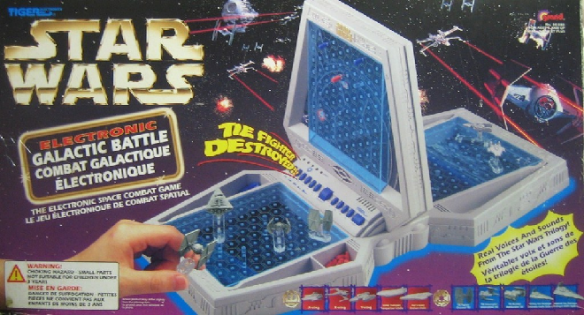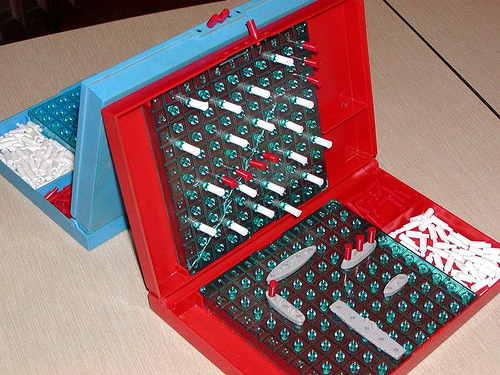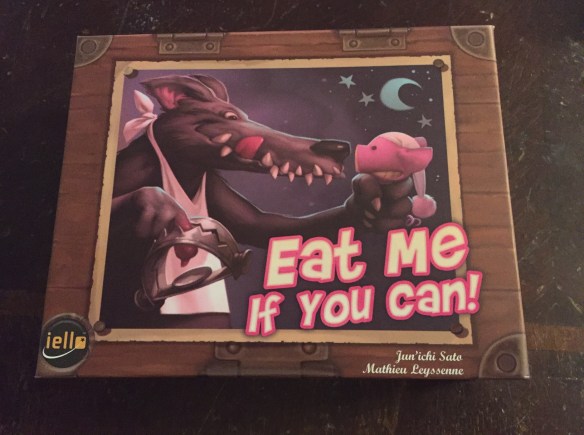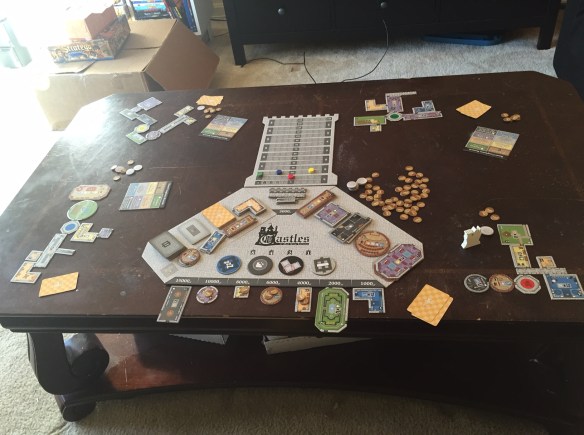I’ve written before that board games are a very social experience for me, as they are for most people. Because of this, I usually associate board games with large groups of people, and  the board game industry looks to be agreeing with me. Games of 3-5 or 4-6 players are becoming the norm in most cases, with plenty of games even exceeding those numbers. So when I was given my blast from the past board game set from my Grandpa it reminded me that a number of older games were actually meant only for two players. Games like Battleship, Guess Who, Stratego and even Chess and Checkers all focus on the one-on-one matchup. There are a few newer games, such as 7 Wonders: Duel, which still use a two-player format, but it feels like this type of game isn’t as common anymore. If anything there are more games now that can be played by two players, but can also include 3+ players, such as Castles of Mad King Ludwig.
the board game industry looks to be agreeing with me. Games of 3-5 or 4-6 players are becoming the norm in most cases, with plenty of games even exceeding those numbers. So when I was given my blast from the past board game set from my Grandpa it reminded me that a number of older games were actually meant only for two players. Games like Battleship, Guess Who, Stratego and even Chess and Checkers all focus on the one-on-one matchup. There are a few newer games, such as 7 Wonders: Duel, which still use a two-player format, but it feels like this type of game isn’t as common anymore. If anything there are more games now that can be played by two players, but can also include 3+ players, such as Castles of Mad King Ludwig.
After recently playing board games of all types over the holidays, I was reminded of some of the benefits of two player board games. While they might not be the best fit for all situations, they can be a lot of fun and have certain benefits that board games for larger groups just don’t have. Here are my top five reasons why you should play two player board games:
1) Easier to get the number of players you need– This advantage seems pretty obvious, but it’s more a testament to how difficult finding groups to play board games with can be at times. I’m lucky enough to have groups of friends who like playing tabletop games, and even I have difficulty finding enough people on a random Tuesday night a
t times. Finding one other person to play a game with you? That tends to be easier. Whether it’s a roommate, a sibling/parent, or a significant other, there are usually people around willing to try a game out with you or open up an old classic.
2) More direct competition– This does not mean to say that games with more than two players don’t have competition. I couldn’t imagine playing a game of Monopoly or Settlers of Catan without forming a grudge match against someone, and even if I don’t there’s enough competition to beat ou t all players and take the #1 spot. Board games are all about trying to win, so there’s going to be a high level of competition in any type of board game you play. Still, there’s something different about the competitive feel of a two person board game. You are essentially using your skills, wits, and strategy to defeat a single opponent; assuming the player is around the same skill level as you the intensity of that matchup can almost feel palpable.
t all players and take the #1 spot. Board games are all about trying to win, so there’s going to be a high level of competition in any type of board game you play. Still, there’s something different about the competitive feel of a two person board game. You are essentially using your skills, wits, and strategy to defeat a single opponent; assuming the player is around the same skill level as you the intensity of that matchup can almost feel palpable.
3) More streamlined game mechanics– This is not always the case, but it seems like rules and procedures for two player games are generally simpler and more streamlined than ones with 3+ players. Adding in more players creates a layer of complexity to a game, because a game designer has to take more factors into account. Sometimes additional rules are created specifically for a larger number of  players, to ensure that the game stays fair to all parties playing. In addition, most games with larger groups of players are meant to allow for different scenarios for each party interacting with each other, so the complexity only increases. A two player game is streamlined because a designer can create the game without worrying about the 3+ player effect and can focus solely on the game mechanics of two people going head to head against each other.
players, to ensure that the game stays fair to all parties playing. In addition, most games with larger groups of players are meant to allow for different scenarios for each party interacting with each other, so the complexity only increases. A two player game is streamlined because a designer can create the game without worrying about the 3+ player effect and can focus solely on the game mechanics of two people going head to head against each other.
4) Great way to catch up with someone– Whenever I visit my Grandpa in PA we always make a point to play a game of Djinn before the trip is over. This has become a tradition between the two of us, and we use it as a time to have some fun and catch up with each other. I tell him about my work, my girlfriend, my plans for the future, and more as he mercilessly beats me in our favorite card game. The same benefit can be found in a two player board game. Sitting down and interacting with another person and learning more about his/her life is great, and a board game can be a great way to facilitate that.
5) Faster playing time– In today’s fast-paced society, an important criteria for a board game is how long it takes to play. Faster does not always mean better of course, but if you’re looking for a game to play that won’t take up your entire evening then odds are high that a two player game will meet that criteria. This is not always true, as there are some two player games that last a long time and there are plenty of larger scale board games that are meant to be finished quickly. Still, with less people in a game to eliminate and/or less people working to achieve a goal, the average playing time for a two player tabletop game is usually less than a larger scale game.
BONUS: Good for date night– This only really works if you have a significant other who likes board games, but a good date night for any couple can be found at the board game table. Board games create interaction and discussion that you don’t get in a movie theater. They are also a cheap alternative to most standard date nights, and are a fun way to make use of your time if you’re staying home rather than going out. It’s not exactly first date material, but it’s a great idea for a nice, relaxing evening with someone you care about. I am lucky enough to have a girlfriend that also likes board games (she’s a fellow blogger, check out http://moviesandmanicures.com/ when you get a chance!) and we played three rounds of Castles of Mad King Ludwig over Christmas. We had a lot of fun and it was a great way to spend time together, so I recommend it for any lovebirds out there as well.


 they have extra foods or “contraband”. The added twist to this is that every round someone acts as “sheriff” who then can choose to inspect each person’s bag. If you were truthful about your goods then the Sheriff has to pay you, but if not the extra goods get confiscated and you have to pay the Sheriff. This means that you can try and smuggle contraband in for big point totals, or you can tell the truth and hope that the Sheriff tries to catch you. A number of other nuances in how you draw cards and what goods you choose to play add up to a very inventive and interesting game.
they have extra foods or “contraband”. The added twist to this is that every round someone acts as “sheriff” who then can choose to inspect each person’s bag. If you were truthful about your goods then the Sheriff has to pay you, but if not the extra goods get confiscated and you have to pay the Sheriff. This means that you can try and smuggle contraband in for big point totals, or you can tell the truth and hope that the Sheriff tries to catch you. A number of other nuances in how you draw cards and what goods you choose to play add up to a very inventive and interesting game. an improv show where everyone put on different accents and asked silly questions to try and get a reaction from the group. This caused everyone to be more engaged in the game and the enthusiasm built up as we went. I feel like if you were in a group of more straight-laced people that wanted to play it normally it could be less exciting, though the strategy and gameplay still appeal to the average player. The game tends to drag at times if the Sheriff takes a long time to ask questions, so 5 players can take a while. Playing with 3 players, on the other hand, adds an extra round to the game so it doesn’t exactly shorten things. I recommend the game with 4 players if possible as the best middle ground option.
an improv show where everyone put on different accents and asked silly questions to try and get a reaction from the group. This caused everyone to be more engaged in the game and the enthusiasm built up as we went. I feel like if you were in a group of more straight-laced people that wanted to play it normally it could be less exciting, though the strategy and gameplay still appeal to the average player. The game tends to drag at times if the Sheriff takes a long time to ask questions, so 5 players can take a while. Playing with 3 players, on the other hand, adds an extra round to the game so it doesn’t exactly shorten things. I recommend the game with 4 players if possible as the best middle ground option.
 the board game industry looks to be agreeing with me. Games of 3-5 or 4-6 players are becoming the norm in most cases, with plenty of games even exceeding those numbers. So when I was given my
the board game industry looks to be agreeing with me. Games of 3-5 or 4-6 players are becoming the norm in most cases, with plenty of games even exceeding those numbers. So when I was given my  t all players and take the #1 spot. Board games are all about trying to win, so there’s going to be a high level of competition in any type of board game you play. Still, there’s something different about the competitive feel of a two person board game. You are essentially using your skills, wits, and strategy to defeat a single opponent; assuming the player is around the same skill level as you the intensity of that matchup can almost feel palpable.
t all players and take the #1 spot. Board games are all about trying to win, so there’s going to be a high level of competition in any type of board game you play. Still, there’s something different about the competitive feel of a two person board game. You are essentially using your skills, wits, and strategy to defeat a single opponent; assuming the player is around the same skill level as you the intensity of that matchup can almost feel palpable. players, to ensure that the game stays fair to all parties playing. In addition, most games with larger groups of players are meant to allow for different scenarios for each party interacting with each other, so the complexity only increases. A two player game is streamlined because a designer can create the game without worrying about the 3+ player effect and can focus solely on the game mechanics of two people going head to head against each other.
players, to ensure that the game stays fair to all parties playing. In addition, most games with larger groups of players are meant to allow for different scenarios for each party interacting with each other, so the complexity only increases. A two player game is streamlined because a designer can create the game without worrying about the 3+ player effect and can focus solely on the game mechanics of two people going head to head against each other.






 get less and less until you lose all of your ships. If on any of your shots you hit a ship, your opponent must tell you where you hit and what ship it was. This speeds up the game significantly and also provides an added layer of strategy for when you’ve hit someone. Ultimately it’s a simple change, but it provides better results in my opinion compared to the traditional version. There is an element of luck to it because if you lose a ship early and have less shots to work with you are at a big disadvantage, but from the times I have played salvo I found that it stayed pretty even no matter how the first few games started solely due to the volume of opportunities to get a hit on your opponent.
get less and less until you lose all of your ships. If on any of your shots you hit a ship, your opponent must tell you where you hit and what ship it was. This speeds up the game significantly and also provides an added layer of strategy for when you’ve hit someone. Ultimately it’s a simple change, but it provides better results in my opinion compared to the traditional version. There is an element of luck to it because if you lose a ship early and have less shots to work with you are at a big disadvantage, but from the times I have played salvo I found that it stayed pretty even no matter how the first few games started solely due to the volume of opportunities to get a hit on your opponent. pencil available because you will need to write down as much information as possible each turn to help figure out which of your shots was a hit. For example, if on your first turn you choose A2, B7, H5, G9, and A10 as your five shots and your opponent tells you that you hit twice, that’s not a lot of information to go on. If you don’t keep a record of the hits and do some experimenting to figure out where those hits came from, it will be impossible for you to keep track of everything as the game progresses. This type of game can be a lot of fun if you play it right, but can also be very frustrating if you don’t keep organized and use your shots wisely.
pencil available because you will need to write down as much information as possible each turn to help figure out which of your shots was a hit. For example, if on your first turn you choose A2, B7, H5, G9, and A10 as your five shots and your opponent tells you that you hit twice, that’s not a lot of information to go on. If you don’t keep a record of the hits and do some experimenting to figure out where those hits came from, it will be impossible for you to keep track of everything as the game progresses. This type of game can be a lot of fun if you play it right, but can also be very frustrating if you don’t keep organized and use your shots wisely.




 but inside there are 30 road cards that create a fairly engaging game
but inside there are 30 road cards that create a fairly engaging game  when spread out. Created by a company called Perplext, Bus focused on players navigating b
when spread out. Created by a company called Perplext, Bus focused on players navigating b

 any of the rooms he/she wants and pays the Master Builder for the cost, then plays the rooms in his/her castle area. Each room has a different effect after it is played, which can get you more money, points, or bonus cards that have different effects. Play continues to the next player on the left, until it is the Master Builder’s turn. The Master Builder then can buy whatever rooms are left (if there are any) by paying the bank. Once the Master Builder finishes his/her turn, the person to the left becomes Master Builder for the next round. Once all of the Room Deck cards have been used up, the game is over and points are calculated.
any of the rooms he/she wants and pays the Master Builder for the cost, then plays the rooms in his/her castle area. Each room has a different effect after it is played, which can get you more money, points, or bonus cards that have different effects. Play continues to the next player on the left, until it is the Master Builder’s turn. The Master Builder then can buy whatever rooms are left (if there are any) by paying the bank. Once the Master Builder finishes his/her turn, the person to the left becomes Master Builder for the next round. Once all of the Room Deck cards have been used up, the game is over and points are calculated.


 ch act as the starting point to your rooms. The first time you play the game, expect to take a very long time organizing and setting everything up (once you’ve played the game a few times it gets a lot faster). Because of how many pieces are involved, make sure that you have a lot of space available to play, especially if you have four players.
ch act as the starting point to your rooms. The first time you play the game, expect to take a very long time organizing and setting everything up (once you’ve played the game a few times it gets a lot faster). Because of how many pieces are involved, make sure that you have a lot of space available to play, especially if you have four players.